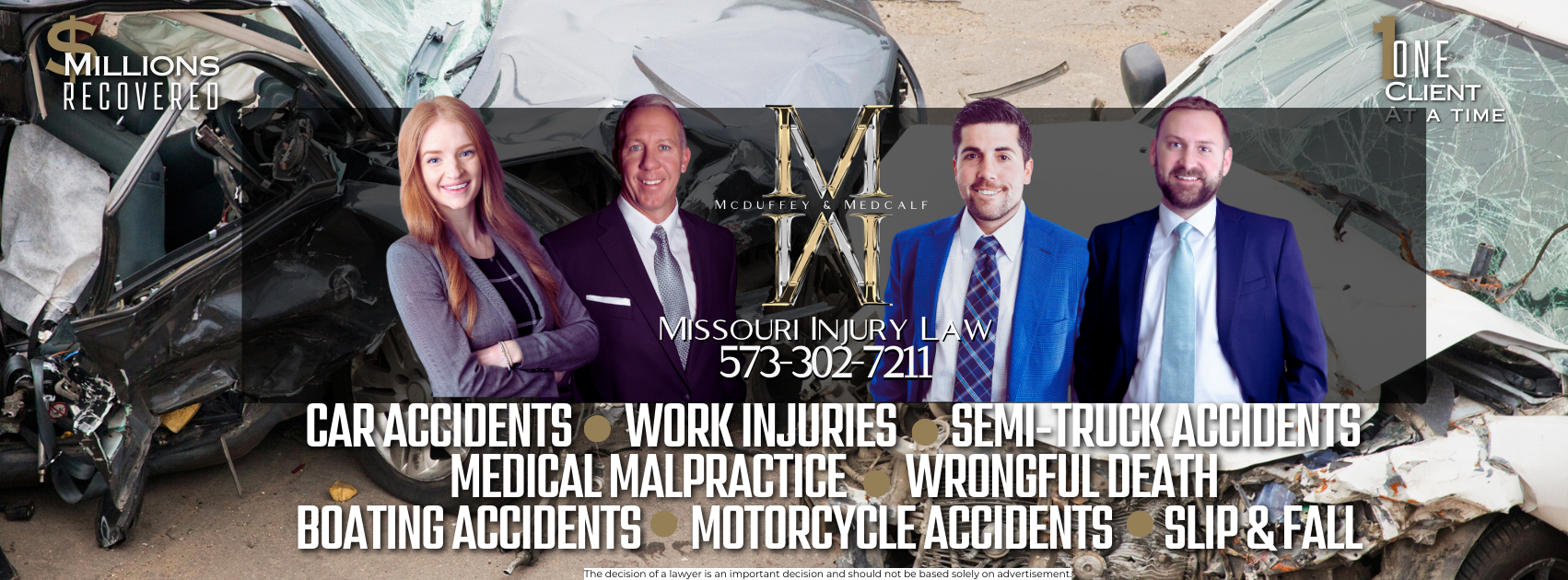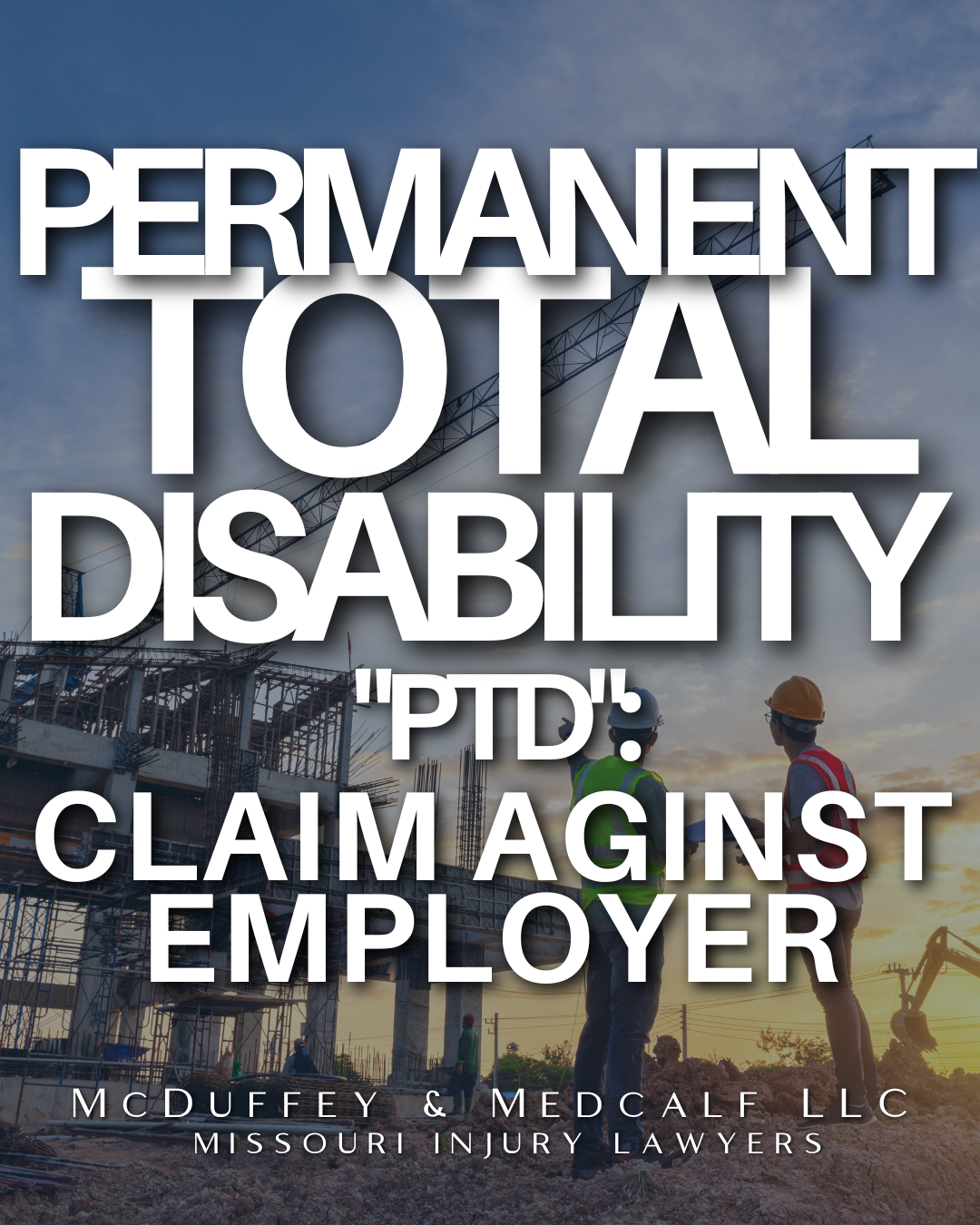PTD Claim Against Employer
For Comprehensive information, be sure to check out our previous posts:
What is Missouri Workers Compensation Law?
The Medical Treatment Benefits in Missouri’s Workers’ Compensation Law
Temporary Total Disability (“TTD”) Benefits
Temporary Partial Disability (“TPD”)
Permanent Partial Disability “PPD” Claim
If instead of the specific injured body part being permanently less ‘able’ due to the work injury, the injured worker is unable to return to full-time unaccommodated work, the injured worker is entitled to permanent total disability benefits. The easiest way to think of that is whether the ‘reasonable’ employer can be reasonably expected to hire the injured worker after his or her work injury. If it is not reasonable to expect an injured worker to compete in the open labor market due to the permanent affects of their work injury, then the injured worker is considered permanently and totally disabled. This does not consider only the job the injured worker had at the time of the work injury. If the injured worker can be reasonably expected to obtain full-time unaccommodated employment in the open labor market, he or she is not permanently and totally disabled. The same is true even if the other job(s) the injured worker is able to perform pays significantly less. A person able to continue working in a full-time unaccommodated capacity is entitled to permanent partial disability benefits.
Employers cannot discriminate against a specific individual for their age, gender, race, disability, etc. That said, employers are allowed to have certain job requirements that are applied equally to all applicants and/or employees. For instance, a construction company might require its employees to be able to lift at least 100 lbs. That is not discriminatory assuming all applicants and employees are required to be able to do that. It is these job requirements that are considered when attempting to determine whether the Injured Worker is permanently and totally disabled.
If a medical doctor feels the work injury has left the injured worker unable to perform certain activities, or perform them at a certain rate, or perform them in a certain environment; then, that doctor will assign permanent restrictions to the injured worker. For example the doctor might say not to lift greater than 10 lbs., not to sit for longer than 45 minutes, not to walk more than 200 yards, and that the injured worker needs to be allowed to lie down or recline once per hour. If that injured worker would apply to the hypothetical construction job that requires its employees to be able to lift 100 lbs., they would not get the job. That injured worker would not be physically capable of performing that job due to the permanent restrictions flowing from the work injury. Likewise, if that injured worker applied for a sedentary desk job, that injured worker would not be qualified for it as he or she would be unable to to sit for sustained periods and the employers would not allow for the employees to work in a bed or recliner in a recumbent fashion.
This is where vocational rehabilitation specialists / experts come into the picture. An able workers’ compensation attorney will be able to arrange for you to be evaluated by a vocational rehabilitation specialist. This person will take your restrictions and consider each jobs basic requirements in the open labor market. The vocational rehabilitation specialist will consider not only the requirements of the injured worker’s job, but all jobs, in order to offer an opinion as to whether the injured worker can be reasonably expected to be hired for full-time unaccommodated work. The vocational rehabilitation specialist will consider the basic requirements of very-heavy, heavy, medium, light, and sedentary jobs. The vocational rehabilitation specialist will also consider the level of training and/or education necessary to be qualified for a give job if the injured worker is physically capable. It does not make sense to tell a 73-year-old concrete worker that he has the physical abilities to be a brain surgeon. The law take ‘life factors’ such as eduction, appearance, work history, and age into account.
Ultimately, if the last / primary work injury on its own is the prevailing factor causing the injured worker to be so limited in his or her abilities that he or she no longer is capable of performing a job he or she would otherwise be qualified for in the open labor market, then that person is permanently and totally disabled as the Missouri Workers’ Compensation system considers it. You will need medical and vocational evidence appropriately submitted into evidence in order to prove this. It is also worth noting that the injured workers cannot have already been incapable of full-time unaccommodated work in the open labor market prior to to work injury due to preexisting injuries/conditions.
If the injured worker is rendered Permanently and Totally Disabled by his or her work injury, when that injury’s permanent affects are considered in isolation (separate from any other injuries or medical conditions), then the employer is liable for payment of Permanent Total Disability (“PTD”) Benefits. These benefits are calculated very differently from the Permanent Partial Disability Benefits. PTD Benefits are meant to account for the work injury having eliminated the Injured Worker’s ability to earn income for the remainder of his or her lifetime.
The weekly rate associated with PTD Benefits is allowed to be significantly higher than the maximum PPD weekly rate. Like PPD, the PTD rate changes each year. Historically, it increases to account for the changing value of money (inflation). With that in mind, in order to calculate a PTD Rate, the Injured Worker still looks to the 13 weeks prior to the date of his or her injury, he or she adds up every pre-tax dollar he or she made in those 13 weeks, and then he or she divides that amount by 13 in order to identify an average. The Injured Worker’s PTD Rate is then 2/3 of that average weekly wage, unless it is in excess of the maximum PTD rate. The maximum PPD and PTD Rates are published online for each year.
Once the PTD Rate is identified, the Injured Worker must identified his or her additional life expectancy. No one know how long he or she is going to live for certain. As such, most attorneys will use the Social Security Administration’s Life Expectancy Calculator to obtain an additional life expectancy for a given Injured Worker. The younger the person, with some variance depending on gender, the longer his or her additional life expectancy might be.
Once the duration of the Injured Workers’ additional life expectancy is identified, one might think all that need be done is to multiple the number of additional weeks he or she is expected to live by the PTD weekly rate in order to learn the appropriate value of his or her claim. Unfortunately, while that is a worthwhile talking exercise for purposes of making it a talking point, it is not that simple for two main reasons.
First, the present value of money is different from the future value of money. Think about what $100 was worth in 1988 versus now. For that reason, the Employer and their Insurer are not going to negotiate based on the gross value of the Injured Worker’s additional life expectancy multiplied by his or her PTD weekly rate. As such, if the Injured Worker is interested in negotiating a lump sum settlement, his or her attorney will run a present value calculation. To state it simply, that calculation takes into account the changing value of money over time.
Second, the Employer and their Insurer are not going to assume the Injured Worker is going to live his or her full additional life expectancy. The additional life expectancy projection is based on date and averages. The Employers and their Insurers are going to view the additional life expectancy projections as a worst case scenario. Before they would pay for a full-life, they will make the weekly payment and make the Injured Worker earn that amount by actually living that long.
With those two additional factors in mind, a lump sum PTD value can be calculated using any number of years of additional life. This is probably easiest understood with a hypothetical example:
Injured Worker Additional Life Expectancy: 20 Years (1,040 Weeks)
Injured Worker PTD Rate: $1,000.00
Gross PTD Lump Sum Value of Full Additional Life: $1,040,000.00
Lump Sum Present Value of Full Additional (20 Years of Payments) Life at 4%: $706k
Lump Sum Present Value of 17 Years of Payments at 4%: $632k
Lump Sum Present Value of 14 Years of Payments at 4%: $550k
Ultimately, because no one can know how long the injured worker is going to live, these data points are essential to the injured worker being able to make an informed decision as he or she considers his or her options. The only thing that the injured worker can ‘win’ at trial is NOT a lump-sum, but the weekly payment. While the lump sum offer is the initial preference of many, appropriate presentation of all the data points allows the injured worker to evaluate how long he or she would have to live before he or she would exceed the value of the lump sum being offered to him or her. For instance, using the hypothetical data points above, if the injured worker were offered $100k, it would take him or her less than 2 years of weekly payments to outlive the value of that offer. In that instance, he or should would in most circumstances prefer the weekly payment to that $100k offer. But, every case is going to be different when evaluating PTD settlements and offers.
the first thing a permanently and totally disabled Missouri Worker needs to determine is his or her additional life expectancy. Speaking in general
If the restrictions associated with the work injury in isolation are not enough, but the Injured Worker is permanently and totally disabled; then Missouri Second Injury Fund is most likely liable for the weekly benefits.

FOR MORE INFORMATION & TO SEE THE LAWYERS AT MCDUFFEY & MEDCALF CAN HELP YOU WITH YOUR PERSONAL INJURY CASE:
CALL 573-302-7211 TO SCHEDULE A FREE CONSULT
EMAIL: br**@*********aw.com
OR SUBMIT YOUR INFORMATION HERE FOR A FREE CASE EVALUATION.








